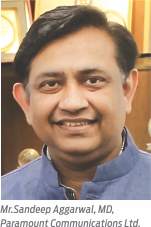Marred by inconsistent demand scenario, the Indian cable industry’s growth pattern is characterized by both the compulsion to increase the size of production and the utilization of existing over-capacities, and this paradoxical situation of course is hampering the growth rate of the industry, feels Mr. Sandeep Aggarwal.
 Paramount Communications Ltd., one of India’s leading cable manufacturing companies, is active for over six decades with one of the most comprehensive range of cabling solutions for diverse applications, which includes power, railways, telecom, IT and communications, construction, defense and space research projects, amongst others. The clientele includes prominent government, institutional, and private sector buyers. Paramount is known to lay great emphasis on manufacturing excellence, technological advancement and customer satisfaction with its unique in-house process control and quality assurance expertise to ensure a high-quality product.
Paramount Communications Ltd., one of India’s leading cable manufacturing companies, is active for over six decades with one of the most comprehensive range of cabling solutions for diverse applications, which includes power, railways, telecom, IT and communications, construction, defense and space research projects, amongst others. The clientele includes prominent government, institutional, and private sector buyers. Paramount is known to lay great emphasis on manufacturing excellence, technological advancement and customer satisfaction with its unique in-house process control and quality assurance expertise to ensure a high-quality product.
WCI recently interviewed Mr. Sandeep Aggarwal, Managing Director, Paramount Communi-cations Ltd. on a host of issues faced by the Indian cable industry, including its growth pattern, hindrances in steady capacity creation, demand inconsistency, unorganized sector’s impact, and the probable effects of GST@28 percent on the industry. Here is what Mr. Aggarwal feels on these issues:
Wire & Cable India: To start with, tell us something about the current trends and challenges in the Indian wire and cable industry.
Sandeep Aggarwal: The Indian cable industry is doing fairly well as compared to its counterparts in Europe and America. The British cable industry, once a leader, is tottering with only two-three cable companies able to survive the challenges of demand maturity. In Europe, except for a few countries like Poland, France and Germany, you won’t find much cable industries; either the plants have shut down or in the process of shutting down. On the contrary, India is having big manufacturing boost and the cable industry is growing because of growing cabling solutions demand in the country, riding on fast growing infrastructure and electrification requirements.
However, growth is just a perspective; India’s growth seems healthy when compared to Europe, having a negative growth whereas the same growth appears tardy if you compare with China’s growth. Where China is using around 300 million km optical fiber every year, India is just at 10 to 15 million, less than even 5 percent of Chinese requirement. The demand ratios for HV and EHV cables also stand in somewhat same bracket as optical fiber. To bridge this huge gap, India in the last 15 years has invested a lot but still has a long way to go. A great irony exists here in terms of capacity expansion and demand – on the one hand, the industry is undergoing capacity expansion at least by 20-30 percent annually, it is fighting for adequate demand for the existing capacity on the other. Covering 50-60 percent of your capacity in India would require you to compromise with the margins.
There are various factors responsible for this inadequate demand for the existing capacities even though the overall demand for the wire and cable is increasing. In fact, the real demand is not percolating to organized wire and cable segment and is somehow being scuttled down by the unorganized sectors in the absence of stringent quality parameters. These unorganized players gulp a sizeable demand by under-quoting and supplying inferior quality goods. On being caught, they simply change their name and resume the business. In the last 10 years, many railways and telecom suppliers have changed their name. We often find railways and telecom cable businesses witnessing negative margins because of such under-quoting and low prices, except few instances of positive margins in railways cable when one or two such players got caught. It is somewhat similar for the power cable sector, with an acceleration seen only in the last few months. EPC contracts are being won at extremely low prices, forcing a contractor to buy cables at low prices resulting in compromise with the quality. If you have to buy a 150 mm sq cable, the actual cable being bought by an EPC contractor is 120 mm sq. This is what discourages the growth of the organized cable industry.
WCI: How are fair practices important for the long-term growth of the cable industry? How do you suggest these fair practices are ensured?
SA: You need to have thorough quality checks after the installation of cable systems, i.e. third party quality checks. If you see Delhi metro, it has that system to ensure quality stringently. The quality in DMRC however has gone down considerably of late and they have blacklisted many companies to control the quality. The third party quality check therefore is absolutely necessary. But, let me tell you that there is problem even with the third party quality checks. The unorganized sector who are actual deceiver, bribe their way through the quality checks. This is how they get rescued from such a situation and standard manufacturers, who doesn’t bribe, get stuck under small pretexts. What we need to do is that we should break the cable sector into ‘minor’ and ‘major’ parameters. Any failure of major parameters should result in stern action. The suppliers should also be divided into major and minor supplier as done for CPWD and other civil contracts to ensure fair competition.
WCI: Tell us your opinion about the GST rate decided for cables. Would it help the Indian wire and cable industry in furthering its growth targets?
SA: There is an issue with differential GST rates in our country. Worldwide, there is a uniform GST rate across the value chain. The fiber starts as silicon, copper as copper ore, aluminum as aluminum ore, plastic as oil; everything starts as a natural resource. I am of the opinion that rate should be one, from the beginning to end. In nutshell, there should be a single GST rate for all manufactured goods.
Had there been a single GST rate, there wouldn’t be any problem. Moreover, putting cables in 28 percent GST slab is also not right where the major raw materials like copper, aluminum, plastic, and steel enjoy 18 percent slab. The GST rate arrived for cables is based on a misnomer that cables were being taxed at VAT@13 percent and Excise@12.5 percent totaling near to 28 percent, which was never the case. The truth however is that 90 percent of cables were charged VAT@5% and Excise@12.5% aggregating at about 18 percent and which should have been the actual GST rate. The higher GST rate for cables will certainly result in tax evasion and tax theft. The huge GST rate difference between the input and output in cable shall allow unorganized sector to manufacture and sell in cash without paying the differential GST and thereby having a price advantage of 12-13 percent over organized sector.
Moreover, the Govt. will get more in terms of tax from standard manufacturers. The unorganized sector is already showing no data of their produce and sale and hence is not a great contributor for any tax regime, old or new. Their alarming growth from 20 percent to 30 percent of market share is also unhealthy for the economy. The Govt. must do something to limit the mushrooming of the unorganized sector and try to bring them in organized category with adequate regulatory measures. The organized sector may also be facilitated and encouraged to produce more and sale more, which also would prove a deterrent to the growth of the unorganized sector. And, one way to do that is to enforce a single GST rate on all raw materials and cables @ 18 percent.
WCI: Despite considerable investments in technology and capacity enhancement, India is way behind China in terms of production capacity, as you earlier underlined. What do you think are the factors for this growth lag?
SA: China’s GDP is three times of India and their investment on capital goods and allied items, cable being one, is about 20 times higher, which exhibits a huge gap. Whatsoever we keep saying about China’s economic model and its ‘probable’ slowdown in economy at just 6-7 percent, and that India’s projected growth at double digits, the matter of fact is that China is steadily surging ahead in all manners of economic and industrial progress. To give you a little perspective of my own, OFCs are nerves for any economy in modern times and China is adding 20 times more such nerves than India, every year. The amount of data being transmitted is doubling every year and Internet of Things (IoT) is the way to future, all resting on these vital nerves. India has not been investing adequately and on right time. From the govt. to govt., there have just been talks and policies formulation and execution have not moved in tandem with time. For example, 17,00,000 km of fiber cable was to be deployed by December 2018 and we have just started witnessing some movements for the last few months. The few orders, which came, came after a lull for three years. Now, the officers would wish to accomplish everything in coming 1.5 years time, which is impossible and it may compel the industry to invest considerable sums in order to carry out such orders in short time. Another probability in such scenario is the Govt.’s inability to buy the full quantity as ordered as what happened the last time, thus laying waste the capacity added. The last time when the new Govt. came, instead of buying the full quantity which was ordered, i.e. 400,000 km, they procured only half of it, i.e. 200,000 km. Now again they are coming up with projects and orders. They may procure again on paper but may end up buying either half or less even. If the industry again puts in a lot of investment and the Govt. is not able to convert it into real buying, industry will suffer huge losses. We can only hope that doesn’t happen again. This was for the telecom sector.
The case is similar for power cables. The govt. of all states are in losses because free power provision policy. Mr. Piyush Goyal has tried to do a lot of work with programs such as Ujwal DISCOM Assurance Yojana (UDAY). Lots of funding has been given to state governments, but they are misusing the funds. Though they are improving, but not at the pace desired. The investment in cable, which is still considered as a premium product over conductor, is not happening.
WCI: Views on the industry in general and expectations?
SA: As I said, there has to be a third party check system on the quality of the products being used, either by the consumers, who are getting duped by the unorganized sector’s players, or by the govt. through stringent quality regulatory system in place. The system should work in such a way that, major aspects of problem in quality are dealt with expeditiously.
WCI: Any new development at Paramount which you like to share?
SA: Paramount grew briskly for a long time. However, the last 5-7 years have not been very rewarding for the industry as a whole. Again, my understanding is that the Govt. is not doing much in terms of project execution and placing orders. The industry is suffering from over-capacity and Paramount would not like to invest in capacity augmentation in such scenario; our company is rather interested in optimum capacity utilization of what we have as of now.
There has been some problems for the last couple of years, but Paramount now is able to step-up its capacity utilization. By the next year, we should be able to utilize 100 percent of our capacity. The company won’t be making any big investment except few small adjustment investments. I strongly believe that the Govt. has to do a lot more before the cable industry starts making profits in proportion to its investments. I believe that this phase of Paramount is more of stabilizing and restructuring existing capacity. And, of course, we are getting into some related businesses. It is sort of forward integration in optical systems. The forward integration will be quite useful and is something which gives immense value addition to the industry. By the next year, I hope I would be able to showcase what we are planning to do.




